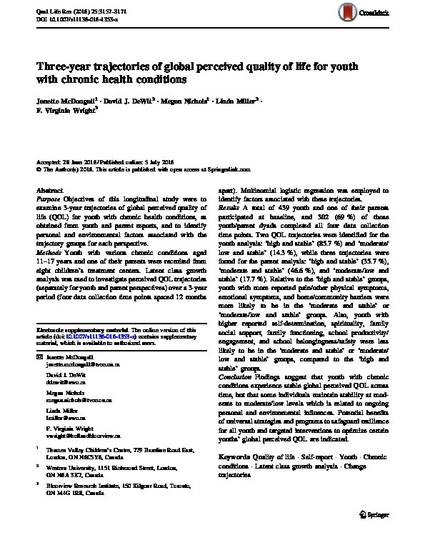
Purpose Objectives of this longitudinal study were to examine 3-year trajectories of global perceived quality of life (QOL) for youth with chronic health conditions, as obtained from youth and parent reports, and to identify personal and environmental factors associated with the trajectory groups for each perspective.
Methods Youth with various chronic conditions aged 11–17 years and one of their parents were recruited from eight children’s treatment centers. Latent class growth analysis was used to investigate perceived QOL trajectories (separately for youth and parent perspectives) over a 3-year period (four data collection time points spaced 12 months apart). Multinomial logistic regression was employed to identify factors associated with these trajectories.
Results A total of 439 youth and one of their parents participated at baseline, and 302 (69 %) of those youth/parent dyads completed all four data collection time points. Two QOL trajectories were identified for the youth analysis: ‘high and stable’ (85.7 %) and ‘moderate/low and stable’ (14.3 %), while three trajectories were found for the parent analysis: ‘high and stable’ (35.7 %), ‘moderate and stable’ (46.6 %), and ‘moderate/low and stable’ (17.7 %). Relative to the ‘high and stable’ groups, youth with more reported pain/other physical symptoms, emotional symptoms, and home/community barriers were more likely to be in the ‘moderate and stable’ or ‘moderate/low and stable’ groups. Also, youth with higher reported self-determination, spirituality, family social support, family functioning, school productivity/engagement, and school belongingness/safety were less likely to be in the ‘moderate and stable’ or ‘moderate/low and stable’ groups, compared to the ‘high and stable’ groups.
Conclusion Findings suggest that youth with chronic conditions experience stable global perceived QOL across time, but that some individuals maintain stability at moderate to moderate/low levels which is related to ongoing personal and environmental influences. Potential benefits of universal strategies and programs to safeguard resilience for all youth and targeted interventions to optimize certain youths’ global perceived QOL are indicated.
Available at: http://works.bepress.com/janette-mcdougall/72/
